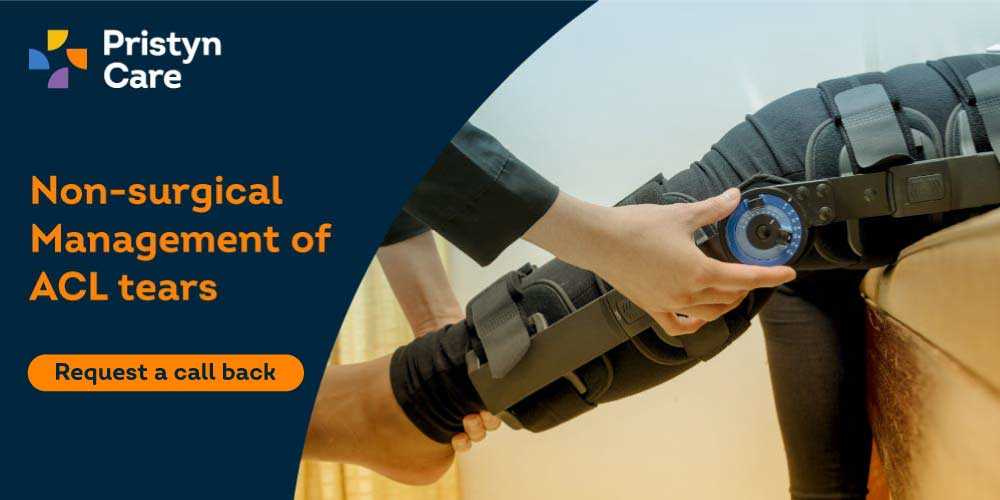
An ACL tear is a tear or sprain in the anterior crucial ligament (ACL), one of the tissues that support the knee joint. It is a very common sports injury and is usually treated surgically, but in patients with mild symptoms and partial tears, the patient can try medical management for ACL tear treatments. Read ahead for a brief overview of the non-surgical management for ACL tears.
Table of Contents
How is the treatment for ACL tear decided?
The choice between medical and surgical treatment for ACL tears does not lie with the patient or the orthopedist. Instead, it depends on the severity of the symptoms, the extent of the tear, the patient’s age and lifestyle, etc.
Your orthopedic doctor will carefully examine the injury site and prescribe diagnostic or imaging tests like X-rays, MRI, ultrasound, etc. On the basis of the results of these examinations, the doctor will formulate the treatment plan and prescribe the appropriate treatment.
It is important that the patient follows their orthopedist’s instructions carefully without fail to prevent the complications of untreated or improperly managed ACL tears. There are pros and cons of both medical and surgical treatments for ACL tears, and before opting for either treatment, the patient should carefully consult their orthopedic doctor.
Also Read- Recovery Timeline and tips for ACL Reconstruction Surgery
Treatments for an ACL tear without surgery
Non-surgical management is only suggested for minor ACL injuries. Following an ACL injury, you should immediately employ the RICE method for self-care. The RICE model can be explained as follows:
- Rest: Rest your knee and do not put weight on it unnecessarily.
- Ice: Try to massage the injured knee with an ice pack for at least 20 minutes every 2 hours.
- Compression: Wrap an elastic or compression bandage around the knee.
- Elevation: Elevate your knee while resting using pillows or something similar.
In addition to these, you should take anti-inflammatory and pain medications to enhance recovery. You can even use a knee brace with crutches to keep the joint immobile and free from pressure while walking.
Physiotherapy for conservative ACL rupture treatment
Once the initial swelling has gone down, the patient will be advised rehabilitation and physical therapy to improve leg strength, knee function and recovery. The rehabilitation generally lasts around 5-8 weeks, after which surgery is recommended if the patient still has knee pain and instability. The rehab program consists of:
- Single- and multiple-joint exercises
- Open and closed kinetic chain exercises
- Concentric, eccentric, and isometric exercises
- Plyometric exercises
All exercises are performed in 3-4 sets with 6-8 repetitions. Plyometric exercises are generally added once the patient has recovered a little, as they focus on the quality of the movement and are tailored to each patient based on their needs. Then, the patient may undergo perturbation training, i.e., dynamic stability exercises on a roller board, rocker board, and platform. Full recovery after medical management of ACL tears usually takes around 3 months.
Also Read- What should you do for knee ligament and meniscus injuries
Who is considered for non-surgical ACL tear considerations?
Generally, medical treatments are only recommended in patients with a sedentary lifestyle or people with a lot of sedentary behavior who do not perform strenuous activities regularly.
Athletes or sports players are usually recommended surgical treatment as soon as possible to improve knee function and prevent chances of complications and re-injury. However, older female athletes who have retained knee function even after the injury can also undergo conservative treatment.
In conclusion, conservative ACL treatment can be prescribed to patients with:
- Partial tears with minimal instability
- Complete tears without knee instability, and low demand for knee function
- Sedentary lifestyle/desk jobs
- Children with open growth plates
Pros and Cons of Non-Surgical Treatment for ACL Tears
Pros
| Cons
|
Everyone’s injuries and bodies are different, and thus their treatment plans differ as well. Thus, the patient should carefully consider all treatment avenues before deciding on anyone and undergo regular consultations with an expert orthopedic doctor until they completely recover.
Also Read- Different Types of Knee Replacement Implants and their Advantages.







